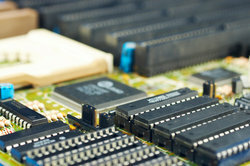Galvanic isolation at SPS
Galvanic isolation (decoupling) is understood to be a potential-free connection, which prevents the charge carriers in electrical circuits from getting from one circuit to another. This galvanic isolation is indispensable, especially with a PLC (programmable logic controller). However, signals or pulses can be transmitted between the circuits, for example by optical transmission (optocoupler, Fiber optic cables), inductive (transformers), with mechanical transmission through compressed air (pneumatic elements) or through insulating mechanical Parts (relays).

Explanations of the programmable logic controller (PLC)
- A programmable logic controller is the successor to the connection-programmed controllers (hard-wired arrangement of relays) and, in addition to controlling and regulating machines, is also increasingly used for visualization, alarming and recording of all Operational messages.
- A classic example of a control system is a PLC with sensors (light barriers, temperature sensors, etc.) at the inputs and actuators (contactors, electr. Valves for hydraulics or pneumatics) at the outputs.
- A PLC works cyclically by reading in the values of all inputs at the beginning of a cycle, the saved ones Executes programs and at the end provides the outputs with the necessary information before the next cycle is started.
- The programmable logic controller (PLC) uses some types of memory such as ROM for Operating system, EPROM for programs and RAM for data storage, mostly by battery is buffered.
Types and application examples of galvanic isolations
- In addition to optocouplers and capacitors, the transformer is a typical example of galvanic isolation in which the lines of the primary circuit do not come into contact with the secondary circuit and this is transmitted via a magnetic field he follows.
- Electrical isolation is also achieved through the use of plastic gear wheels - as in hand drills - and separates metallic drive parts from external, touchable metallic parts.
- Galvanic isolation can be found in many everyday objects. This applies to all mains-operated devices, electrical toys, power supplies and chargers protective separations and, in the case of devices for measurement (current clamps, multimeters), one Electrical isolation.
- Galvanic isolations also prevent so-called ground loops and electromagnetic ones, for example Interferences in audio devices and in remote data transmission and serve to protect against electromagnetic pulse (EMP).
Process image with PLC - an understandable explanation
In machine production, a PLC (programmable logic controller) is often used ...
Galvanic isolation using the example of a PLC
- In PLC systems, digital signals from numerous sensors are transmitted to a controller for further processing. In order to control the voltage level on the user side or Galvanic isolation is essential to be able to work with them.
- Digital isolators, optocouplers and electromagnetic isolators are used for galvanic separation in PLC systems between analog / digital converter and digital / analog converter as well as for separating the signal processing and the Controller.
- In some cases, galvanic isolation is also necessary on the analog side of the PLC; this is then in A converter for all input and output channels for the highest possible isolation between the channels necessary.
- Galvanic isolations also prevent the transmission of transients (which cannot be foreseen over time, random higher-frequency signals in the form of unsteady vibrations) that arise at the signal sources can.
How helpful do you find this article?



